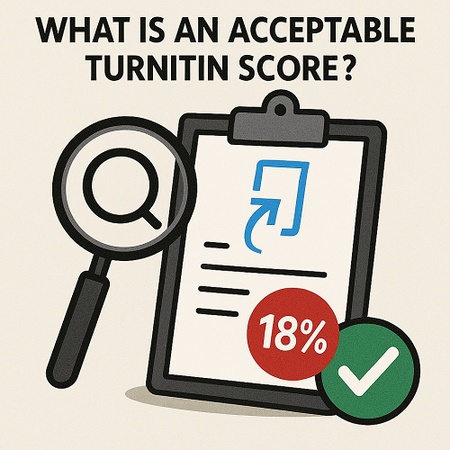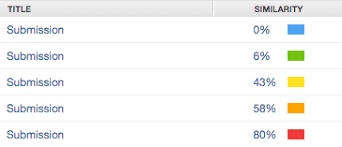What Is an Acceptable Turnitin Score and How to Lower High Similarity Rates
You just submitted your essay to Turnitin. A few minutes later, your screen flashes back with a similarity score of 27% . Your heart sinks. What does this mean? Did you do something wrong? Will your teacher think you copied?
If you've ever felt this way, you're not alone. Many students feel confused or anxious when they see a Turnitin report, especially if they don't fully understand how the system works. In this article, we'll walk you through everything you need to know about Turnitin scores. You'll learn what is an acceptable Turnitin score , and how to handle high scores.
Catalogs:
How Does Turnitin Detect Student Collusion?

Turnitin checks not just public sources but also previously submitted student papers. If two students submit work with the same or very similar content, even across years or institutions, Turnitin will flag this as potential collusion.
The tool uses algorithms to detect shared language, similar structure, and direct matches. That's why copying from friends, old assignments, or shared templates can result in a high similarity score.
What Do the Similarity Score Colors Indicate?

Turnitin uses different colors to help you quickly understand how much of your work matches other sources. Each color represents a range of similarity percentages:
| Color | Similarity Range | Meaning |
|---|---|---|
| Blue | 0% | No matching text found. Your work is fully original. |
| Green | 1%–24% | Low similarity. Usually safe if properly cited. |
| Yellow | 25%–49% | Moderate similarity. May need review. |
| Orange | 50%–74% | High similarity. Likely to raise concerns. |
| Red | 75%–100% | Very high similarity. Often flagged as problematic. |
While the color gives a quick overview, it doesn't tell the full story. A 30% score in yellow with proper citations might be acceptable, while a 15% score in green with poor referencing could still raise red flags. Always check your detailed report and review the matches carefully.
Also Read: What Do the Different Colors Mean in Turnitin Report?
What Turnitin Score is Acceptable?
An acceptable Turnitin score depends on your school, teacher, and assignment. As a general rule:
-
0--15% : Safe for most assignments. This usually means your work is original or properly cited.
-
16--25% : Often okay but may need a closer look. It could include cited quotes or minor overlaps.
-
26% and above : Likely to raise concerns. Your teacher may check for uncited content or plagiarism.
Always check your school's guidelines. Some assignments, like essays with lots of quotes, may naturally have higher scores. Reviewing your Turnitin report can help you spot and fix issues.
Also Read: What Is a Good Turnitin Score?
What is an Acceptable Turnitin Score for Dissertation?
Dissertations often have slightly higher similarity scores because they include extensive literature reviews and citations. A score of 10--20% is usually fine, as long as all sources are cited correctly. Common issues include over-quoting or using standard terms in your field. To keep your score low, paraphrase carefully, cite every source, and ask your teacher if bibliographies can be excluded from the report.
What is an Acceptable Turnitin Score for AI?
Turnitin now has tools to detect AI-generated content, like text from ChatGPT. If your paper is flagged as AI-written, it could affect your score. Most schools expect a 0% AI detection score, but some allow 5--10% if AI use is disclosed. To stay safe, use AI tools only for brainstorming or drafts, then rewrite in your own words. Always check your school's policy on AI use to avoid penalties.
What is an Acceptable Similarity Score on Turnitin?
A "normal" similarity score is typically 0--15% for most assignments. Scores of 16--25% can be okay if you've cited everything properly. Anything higher usually needs revision. Some schools set strict limits, like 20% , while others review case-by-case. You can lower your score by excluding references or quotes in the Turnitin settings, which gives a clearer picture of your original work.
Also Read: Understanding Turnitin Similarity Score
What is an Acceptable Originality Score on Turnitin?
The originality score is the opposite of the similarity score. For example, a 20% similarity score means an 80% originality score. Most schools aim for 85--100% originality, depending on the assignment. To boost your originality, focus on writing in your own words and citing sources correctly. This shows your work is unique while still building on existing research.
More Tips for Using Turnitin
Here are some practical tips to get the most out of Turnitin:
-
Check the report : Look at the similarity report to see which parts of your paper were flagged. This helps you fix issues before submitting.
-
Submit drafts early : Many schools let you submit drafts to Turnitin. Use this to check your score and make changes.
-
Paraphrase well : Don't just copy and paste. Rewrite ideas in your own words and cite the source.
-
Cite everything : Always give credit to the original author, even for small quotes or ideas.
These steps can help you keep your score low and avoid problems.
Reduce Your AI Score Effectively with Tenorshare AI Bypass
If you used AI to draft your work, you should always rewrite it before submitting. AI detection tools can spot robotic or repetitive phrases. To fix this, try Tenorshare AI Bypass . It helps you:
-
Rewrite AI content into human-like language.
-
Avoid being flagged by Turnitin's AI detectors.
-
Keep your ideas while making your writing more personal.
With just one click on "Humanize," your content becomes safer to submit.

Conclusion
Understanding your Turnitin score can take the stress out of submitting your assignments. For most students, a similarity score under 20% is acceptable. If you're writing a dissertation or a heavily researched paper, aim for under 15% . Always make sure your citations are clear and your work reflects your own thinking.
If you're using AI tools to brainstorm or draft content, it's important to rewrite the results in your own words. Tools like Tenorshare AI Bypass can help you humanize AI-generated text and lower your detection risk. With just one click, you can turn robotic writing into natural, original content that feels like you.
FAQs
What is an OK percentage for Turnitin?
A score of 0--15% is usually fine, but check with your teacher or school for specific rules.
What is an acceptable Turnitin score for UniSA?
The University of South Australia often accepts scores below 20%, but confirm with your instructor.
What is an acceptable plagiarism score on Turnitin?
Ideally, 0--15% with all sources cited. Uncited matches could signal plagiarism.
What is an acceptable Turnitin score for students?
Generally, 0--15% is safe, though 16--25% may be okay if citations are correct.
Is 25% a bad Turnitin score?
It's not always bad. If the score comes from cited quotes, it may be fine. Otherwise, revise.
Is 40% similarity on Turnitin bad?
Yes, 40% is usually too high. Check for uncited content or excessive quotes and revise.
Is 20% too high on Turnitin?
It depends. For assignments with lots of citations, 20% may be okay. For original work, aim lower.
Is 46% a bad Turnitin score?
Yes, 46% is concerning. Review the report for uncited matches or over-quoting and make changes.

Tenorshare AI Bypass
- Create 100% undetectable human-like content
- Bypass all AI detector tools like GPTZero, ZeroGPT, Copyleaks, etc.
- Original content, free of plagiarism and grammatical errors
- One-click AI bypass with a clean and easy-to-use interface
You Might Also Like
- What Is a Good Turnitin Score? Easy Guide for Academic Papers
- What Do the Different Colors Mean in Turnitin Report?
- What Is Mosaic Plagiarism? Uncover the Hidden Trap in Writing
- How Does ExamSoft Examplify Detect Cheating? What You Should Know
- What Percentage Is Considered Plagiarism? Comprehensive & Reliable
- 2026 Latest Answer: Is Canvas Down Right Now?
